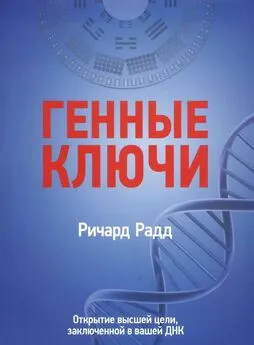Бен Линч - Грязные гены. «Большая стирка» для вашей ДНК. Как изменить свою наследственность
- Название:Грязные гены. «Большая стирка» для вашей ДНК. Как изменить свою наследственность
- Автор:
- Жанр:
- Издательство:Эксмо
- Год:2019
- Город:Москва
- ISBN:978-5-04-094527-6
- Рейтинг:
- Избранное:Добавить в избранное
-
Отзывы:
-
Ваша оценка:
Бен Линч - Грязные гены. «Большая стирка» для вашей ДНК. Как изменить свою наследственность краткое содержание
Автор этой книги, доктор Бен Линч сравнивает наши действия по очистке генов с обыкновенной стиркой одежды и представляет собственноручно разработанную программу, которая предполагает и «замачивание», и прицельное «оттирание пятен» и «бережное отбеливание». Следуя его советам, вы сможете определить, какой ген у вас функционирует неправильно и что необходимо сделать, чтобы устранить проблему.
Внимание! Информация, содержащаяся в книге, не может служить заменой консультации врача. Перед совершением любых рекомендуемых действий необходимо проконсультироваться со специалистом.
Грязные гены. «Большая стирка» для вашей ДНК. Как изменить свою наследственность - читать онлайн бесплатно ознакомительный отрывок
Интервал:
Закладка:
84. Superoxide leading to diabetic complications: Giacco, Ferdinando, Brownlee, Michael. “Oxidative stress and diabetic complications,” Circulation Research, 29 October 2010, https://www.ncbi.nlm.nih.gov/pmc/articles/PMC2996922/.
85. Diabetic complications: Katakam, PV., et al. “Insulin-induced generation of reactive oxygen species and uncoupling of nitric oxide synthase underlie the cerebrovascular insulin resistance in obese rats,” Journal of Cerebral Blood Flow and Metabolism, May 2012, https://www.ncbi.nlm.nih.gov/pubmed/22234336.
86. Potential for congenital heart defect: Feng Q., et al. “Development of heart failure and congenital septal defects in mice lacking endothelial nitric oxide synthase,” Circulation, 13 August 2002, https://www.ncbi.nlm.nih.gov/pubmed/12176963.
87. Potential for congenital heart defect: Liu Y., et al. “Nitric oxide synthase-3 promotes embryonic development of atrioventricular valves,” PLoS One, 29 October 2013, https://www.ncbi.nlm.nih.gov/pubmed/24204893.
88. Most common birth defect in humans: Liu, Y., Feng, Q. “NOing the heart: role of nitric oxide synthase-3 in heart development,” Differenciation, July 2012, https://www.ncbi.nlm.nih.gov/pubmed/22579300.
89. 400 conditions when NOS3 is dirty: “Genopedia: NOS3,” Center for Disease Control and Prevention, Accessed April 2017, https://phgkb.cdc.gov/HuGENavigator/huGEPedia.do?firstQuery=NOS3&geneID=4846&typeSubmit=GO&check=y&typeOption=gene&which=2&pubOrderType=pubD.
90. 400 conditions when NOS3 is dirty: “NOS3,” Mala Cards, Accessed April 2017, http://www.malacards.org/search/results/NOS3.
91. Erectile Dysfunction: Musicki, B., Burnett, AL. “eNOS function and dysfunction in the penis,” Experimental Biology and Medicine, February 2006, https://www.ncbi.nlm.nih.gov/pubmed/16446491/.
92. Runny nose and high blood pressure: Kirchheimer, Sid. “Sniffing Out High Blood Pressure Risk,” WebMD, 18 February 2003, http://www.webmd.com/hypertension-high-blood-pressure/news/20030218/sniffing-out-high-blood-pressure-risk#1.
93. Effects of dirty NOS3 during pregnancy: Leonardo, DP. et al. “Association of Nitric Oxide Synthase and Matrix Metalloprotease Single Nucleotide Polymorphisms with Preeclampsia and Its Complications,” PLoS One, 28 August 2015, https://www.ncbi.nlm.nih.gov/pubmed/26317342.
94. Heart disease increase after menopause: “Hormone replacement therapy and your heart,” Mayo Clinic, 09 July 2015, http://www.mayoclinic.org/diseases-conditions/menopause/in-depth/hormone-replacement-therapy/art-20047550.
95. Lower estrogen after menopause and increased cardiovascular risk: Hayashi, T. et al. “Effect of Estrogen on Isoforms of Nitric Oxide Synthase: Possible Mechanism of Anti-Atherosclerotic Effect of Estrogen,” Gerontology, 15 April 2009, http://www.karger.com/Article/Abstract/213883.
96. Statins stimulate nitric oxide: Cerda, Alvaro et al. “Role of microRNAs 221/222 on Statin Induced Nitric Oxide Release in Human Endothelial Cells,” Arquivos Brasileiros de Cardiologia, March 2015, https://www.ncbi.nlm.nih.gov/pmc/articles/PMC4386847/.
97. Side effects of statins: “Side Effects of Cholesterol-Lowering Statin Drugs,” WebMD, Acessed April 2017, http://www.webmd.com/cholesterol-management/side-effects-of-statin-drugs#1.
98. Statins ineffective with dirty NOS3: Hsu, CP. et al. “Asymmetric Dimethylarginine Limits the Efficacy of Simvastatin Activating Endothelial Nitric Oxide Synthase,” Journal of the American Heart Association, 18 April 2016, https://www.ncbi.nlm.nih.gov/pubmed/27091343.
99. Nitroglycerin resistance: Münzel, T. et al. “Effects of long-term nitroglycerin treatment on endothelial nitric oxide synthase (NOS III) gene expression, NOS III-mediated superoxide production, and vascular NO bioavailability,” Circulation Research, 7 January 2000, https://www.ncbi.nlm.nih.gov/pubmed/10625313.
100. Ineffectiveness of nitroglycerin in smokers: Haramaki, N. et al. “Long-term smoking causes nitroglycerin resistance in platelets by depletion of intraplatelet glutathione,” Arteriosclerosis, Thrombosis, and Vascular Biology, November 2001, https://www.ncbi.nlm.nih.gov/pubmed/11701477.
101. Nitroglycerin and arginine with NOS3: Daiber A., Münzel T. “Organic Nitrate Therapy, Nitrate Tolerance, and Nitrate-Induced Endothelial Dysfunction: Emphasis on Redox Biology and Oxidative Stress,” Antioxidants & Redox Signaling, 10 October 2015, https://www.ncbi.nlm.nih.gov/pubmed/26261901.
102. Arginine steal: Pernow, J., Jung, C. “Arginase as a potential target in the treatment of cardiovascular disease: reversal of arginine steal?” Cardiovascular Research, 1 June 2013, https://www.ncbi.nlm.nih.gov/pubmed/23417041.
103. Bacteria stealing arginine: Cunin, Raymond et al. “Biosynthsis and Metabolism of Arginine in Bacteria,” Microbiological Reviews, September 1986, http://europepmc.org/backend/ptpmcrender.fcgi?accid=PMC373073&blobtype=pdf.
104. Arginine ineffective in increasing nitric oxide: Giam, B. et al, “Effects of Dietary l-Arginine on Nitric Oxide Bioavailability in Obese Normotensive and Obese Hypertensive Subjects,” Nutrients, 14 June 2016, https://www.ncbi.nlm.nih.gov/pubmed/27314383.
105. BH4 given to support NOS3: Vásquez-Vivar, J. et al. “Altered tetrahydrobiopterin metabolism in atherosclerosis: implications for use of oxidized tetrahydrobiopterin analogues and thiol antioxidants,” Arteriosclerosis, Thrombosis, and Vascular Biology, 1 October 2002, https://www.ncbi.nlm.nih.gov/pubmed/12377745.
106. Effectiveness of BH4 given to support NOS3: Mäki-Petäjä, KM. et al. “Tetrahydrobiopterin Supplementation Improves Endothelial Function But Does Not Alter Aortic Stiffness in Patients With Rheumatoid Arthritis,” Journal of the American Heart Association, 19 February 2016, https://www.ncbi.nlm.nih.gov/pubmed/26896473.
107. How the body uses arginine: Förstermann, Ulrich, Sessa, William C. “Nitric oxide synthases: regulation and function,” European Heart Journal, April 2012, https://www.ncbi.nlm.nih.gov/pmc/articles/PMC3345541/.
108. Folic acid increases, level of BH4 decreases: Smith, Desirée E.C. et al. “Folic acid, a double-edged sword? Influence of folic acid on intracellular folate and dihydrofolate reductase activity,” Semantic Scholar, Accessed January 2017, https://pdfs.semanticscholar.org/d934/683d6176b469ff636c4e202b8f99f6bb7217.pdf
109. Sleep apnea and NOS3: Badran, Mohammad et al. “Nitric Oxide Bioavailability in Obstructive Sleep Apnea: Interplay of Asymmetric Dimethylarginine and Free Radicals,” Sleep Disorders, 2015, https://www.ncbi.nlm.nih.gov/pmc/articles/PMC4438195/.
110. Elevated levels of homocysteine leads to increased levels of ADMA: Selley, ML. “Increased concentrations of homocysteine and asymmetric dimethylarginine and decreased concentrations of nitric oxide in the plasma of patients with Alzheimer’s disease,” Neurobiology of Aging, November 2003, https://www.ncbi.nlm.nih.gov/pubmed/12928048.
111. High ADMA levels found in dementia: Selley, ML. “Increased concentrations of homocysteine and asymmetric dimethylarginine and decreased concentrations of nitric oxide in the plasma of patients with Alzheimer’s disease,” Neurobiology of Aging, November 2003, https://www.ncbi.nlm.nih.gov/pubmed/12928048.
112. Heart disease related death in dementia patients: Brunnström, HR., Englund, EM. “Cause of death in patients with dementia disorders,” European Journal of Neurology, April 2009, https://www.ncbi.nlm.nih.gov/pubmed/19170740.
113. BH4 has no benefit if oxidative stress is present: Kirsch, Michael et al. “The Autoxidation of Tetrahydrobiopterin Revisited,” The Journal of Biological Chemistry, 24 April 2003, http://www.jbc.org/content/278/27/24481.abstract.
114. BH4 has no benefit if oxidative stress is present: Vásquez-Vivar, Jeannette. “Tetrahydrobiopterin, Superoxide and Vascular Dysfunction,” Free Radical Biology and Medicine, 21 July 2009, https://www.ncbi.nlm.nih.gov/pmc/articles/PMC2852262/.
11: PEMT: клеточные мембраны и печень
115. Role of phosphatidylcholine: Vance, Dennis E., Li, Zhaoyu, Jacobs, Rene L. “Hepatic Phosphatidylethanolamine N-Methyltransferase, Unexpected Roles in Animal Biochemistry and Physiology,” The Journal of Biological Chemistry, 16 November 2007, http://www.jbc.org/content/282/46/33237.full.pdf.
116. Role of phosphatidylcholine: “Choline,” Oregon State University Linus Pauling Institute Micronutrient Information Center, Accessed April 2017, http://lpi.oregonstate.edu/mic/other-nutrients/choline.
117. Phosphatidylcholine helps move triglycerides: “Choline,” Oregon State University Linus Pauling Institute Micronutrient Information Center, Accessed April 2017, http://lpi.oregonstate.edu/mic/other-nutrients/choline.
12. Курс «Замочить и оттереть». Первые две недели
118. Choline: An Essential Nutrient for Public Health: Steven H. Zeisel, M.D., Ph.D.; Kerry-Anda Costa, Ph.P, Nutr. Rev., November 2009, https://www.ncbi.nlm.nih.gov/pmc/articles/PMC2782876/
119. Polymorphism of the PEMT gene and susceptibility to nonalcoholic fatty liver disease (NAFLD), Faseb J., 19 August 2005, http://www.ncbi.nlm.nih.gov/pubmed/16051693
120. Choline and risk of neural tube defects in a folate-fortified population, Epidemiology, September 2009, http://www.ncbi.nlm.nih.gov/pubmed/19593156
121. Choline Intake During Pregnancy and Child Cognition at Age 7 Years, Am. J Epidemiol, 15 June 2013, https://www.ncbi.nlm.nih.gov/pmc/articles/PMC3676149
122. Early second trimester maternal plasma choline and betaine are related to measures of early cognitive development in term infants, PLoS One, August 2012, http://www.ncbi.nlm.nih.gov/pubmed/22916264
123. Choline: an essential nutrient for public health, Zeisel SH, da Costa KA, Nutr. Rev., November 2009, http://www.ncbi.nlm.nih.gov/pubmed/19906248
124. Choline: Critical Role During Fetal Development and Dietary Requirements in Adults, Steven H. Zeisel, Annu Rev Nutr, 2006, https://www.ncbi.nlm.nih.gov/pmc/articles/PMC2441939
125. Benefits of organic food: Aubrey, Allison. “Is Organic More Nutritious? New Study Adds To The Evidence,” NPR, 18 February 2016, http://www.npr.org/sections/thesalt/2016/02/18/467136329/is-organic-more-nutritious-new-study-adds-to-the-evidence.
126. Dirtiest fruits and vegetables: “All 48 Fruits and Vegetables With Pesticide Residue Data,” Environmental Working Group (EWG), Accessed April 2017, https://www.ewg.org/foodnews/list.php.
13. Рецепты по «чистке» генов
14. Анкета № 2: Какие гены нуждаются в дополнительной «чистке»?
15. Курс «Чистка пятен». Вторые две недели
127. Metformin increases histamine: Yee, SW. et al. “Prediction and validation of enzyme and transporter off-targets for metformin,” Journal of Pharmacokinetics and Pharmacodynamics, October 2015, https://www.ncbi.nlm.nih.gov/pubmed/26335661.
128. Aspirin and other NSAIDs led to increased histamine release: Matsuao, H. et al. “Aspirin augments IgE-mediated histamine release from human peripheral basophils via Syk kinase activation,” Allergology International, December 2013, https://www.ncbi.nlm.nih.gov/pubmed/24153330.
129. Aspirin and other NSAIDs led to increased histamine release: Pham, Duy Le et al. “What we know about nonsteroidal anti-inflammatory drug hypersensitivity,” Korean Journal of Internal Medicine, 5 March 2016, https://www.ncbi.nlm.nih.gov/pmc/articles/PMC4855107/pdf/kjim-2016-085.pdf.
Читать дальшеИнтервал:
Закладка:







![Надежда Нелидова - Большая стирка [сборник]](/books/1095713/nadezhda-nelidova-bolshaya-stirka-sbornik.webp)

